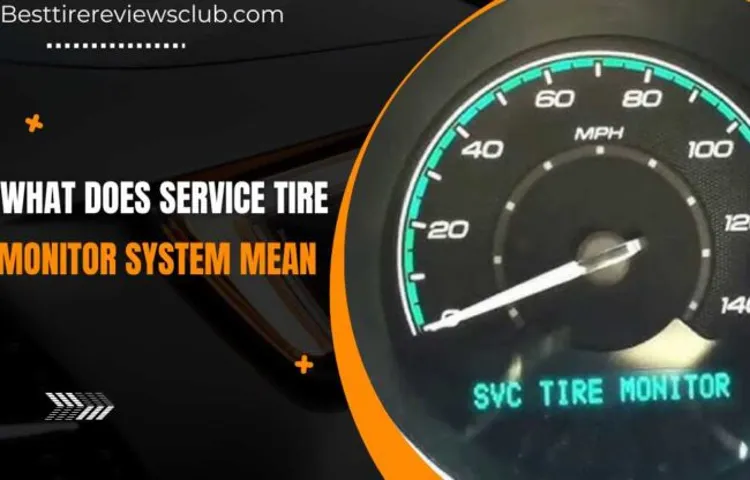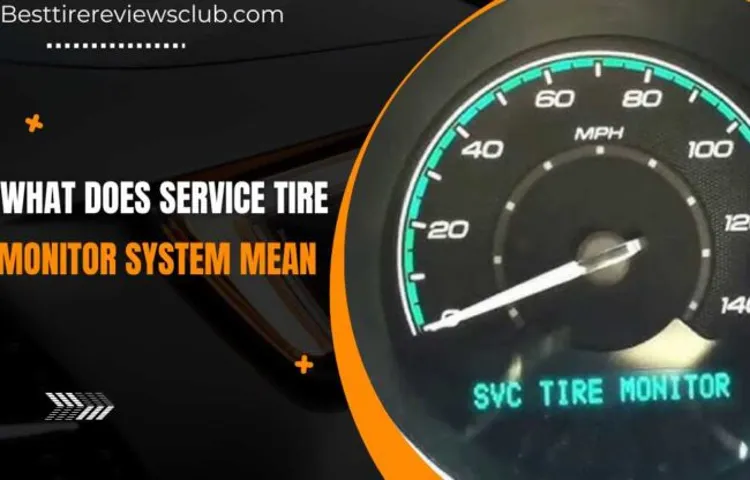If you’re a car owner, you know how important it is to maintain your vehicle. One crucial area that’s often overlooked is the tires. After all, they’re the only part of your car that comes in contact with the road.
That’s where a tire service monitor system comes in handy. This technology allows you to keep track of the condition of your tires, so you can prevent any problems before they become major issues. But what exactly is a tire service monitor system, and how does it work? Let’s dive in.
Table of Contents
Definition and Functionality
If you’re wondering what a tire service monitor system means, simply put, it’s a device that keeps track of your vehicle’s tire pressure. It’s a valuable addition to any car since underinflated tires can lead to decreased fuel efficiency and even accidents. This monitoring system alerts the driver when the tire pressure becomes low, ensuring that the tires maintain optimal pressure.
The technology can be either direct or indirect, with direct systems using sensors to send alerts when the tire pressure falls below a certain threshold. Indirect systems, on the other hand, use the car’s existing ABS (Anti-lock Braking System) sensors to determine problems with tire pressure. Whichever system is chosen, it provides peace of mind and a safer driving experience for you and your passengers.
Monitoring Tire Pressure
Tire pressure monitoring is becoming increasingly important for vehicle safety and efficiency. But what exactly is tire pressure monitoring, and how does it work? Simply put, tire pressure monitoring is a system that constantly monitors the air pressure in your vehicle’s tires. This helps to ensure that your tires are properly inflated, which can help to prevent accidents and extend the life of your tires.
The system works by using pressure sensors located in the tires or on the valve stems to transmit data to the vehicle’s onboard computer. The computer then uses this information to alert the driver if the tire pressure is too high or too low. With proper tire pressure monitoring, you can reduce the risk of accidents caused by blowouts or loss of control, and you can also improve fuel efficiency by keeping your tires properly inflated.
So, if you want to keep your vehicle running safely and efficiently, it’s important to keep an eye on your tire pressure and invest in a reliable tire pressure monitoring system.

Tracking Tire Wear
Tire wear refers to the gradual thinning of treads on a tire’s surface due to continuous usage. It occurs as the tire rubs against different surfaces and endures friction and regular wear and tear. Tracking tire wear is an essential aspect of vehicle maintenance that involves measuring the extent of tire wear to determine the tire’s durability and overall performance.
Tire wear can reflect several things about a vehicle, including improper alignment, over-inflation, under-inflation or irregular tire rotation. It can also influence other aspects of a car, such as fuel economy, ride comfort, and the performance of brakes and suspension systems. Thus, keeping track of tire wear is crucial to ensuring a vehicle’s optimum functionality and safety on the road.
Regular maintenance, such as monitoring tire wear, will extend the life of your tires.
Detecting Tire Damage
Tire damage can come in different forms, and it is essential to know how to detect them to ensure safety while driving. Tires wear out over time, and this can result in cracks, punctures, and bulging, causing a potential hazard while on the road. One way to know if your tire is damaged is by performing a visual inspection.
Check for any cuts or tears on the tire’s sidewall or tread, as well as any foreign objects that may have penetrated its surface. You should also check for bulges or blisters that may signify a weak spot in the tire. Avoid driving on a tire that has damaged sidewalls or tread as it can lead to a blowout.
To maintain optimal tire performance, it’s essential to have them checked regularly by a qualified mechanic. In summary, detecting tire damage is crucial for ensuring a safe and smooth ride, and regular inspection can help prevent unexpected tire failure.
How Does a Tire Service Monitor System Work?
If you’ve ever wondered what a tire service monitor system means, we’ve got you covered. Basically, it’s a system that constantly monitors your tire’s pressure and temperature, alerting you if they’re outside of the recommended range. This system typically uses sensors mounted inside each tire that transmit data wirelessly to the car’s computer.
The computer then analyses the data and if any issues are detected, it will send a warning to the driver. Plus, some tire service monitor systems can display tire pressure and temperature on the dashboard, making it easier for drivers to keep an eye on their tires. This advanced technology helps prevent flat tires or blowouts and can also improve fuel efficiency and overall vehicle performance.
So, next time you see a warning light on your dashboard or notice a change in your car’s handling, it may be time to get your tires checked.
Sensors and Transmitters
Sensors and Transmitters One of the most critical components of a tire service monitoring system (TPMS) is the sensor that relays information about tire pressure and temperature to the vehicle’s onboard computer system. A TPMS generally consists of four sensors, one mounted on each tire’s inner liner, which broadcast data wirelessly to the car’s computer. The sensors generally employ either a pressure-sensitive resistor or a microcontroller to gauge tire pressure and temperature, with readings typically updated every few seconds.
Once the sensor detects an issue, such as low pressure or a spike in temperature, it will trigger a warning light on the dashboard, alerting the driver to take action. Additionally, some TPMS systems use transmitters to relay this data to remote devices, including smartphones and tablets, to help drivers monitor tire health more closely. These sensors are an integral part of modern tire technology, helping drivers not only stay safe on the road but also save money on fuel and tire replacement costs over time.
Dashboard Display
Tire Service Monitoring System Have you ever wondered how a tire service monitoring system works? Well, it’s pretty simple, actually. The system is connected to sensors on each tire that detect pressure and temperature levels. These sensors then transmit the information to a central control unit, which processes the data and alerts the driver if there is a problem with the tires.
This display is usually located on the dashboard of the vehicle and provides real-time updates on the tire pressure, temperature, and overall condition. This system is incredibly useful for keeping your tires in good working condition and ensuring your safety on the road. It can also help you save money by catching potential issues before they become expensive repairs.
Keep an eye on your dashboard display and stay safe out there!
Benefits of a Tire Service Monitor System
If you’ve ever wondered what does tire service monitor system mean, it’s a device that constantly monitors the air pressure and temperature of your vehicle’s tires. This system delivers numerous benefits to drivers, such as improved safety and efficiency, better fuel economy, and enhanced tire lifespan. By keeping an eye on your tires, you are less likely to experience sudden blowouts, flat tires, or uneven wear.
You’ll also be able to identify potential issues early on, such as slow leaks, and address them before they turn into bigger problems. Additionally, a tire service monitor system can help you save money by ensuring that your tires are always inflated to the correct pressure, which will result in better traction, less rolling resistance, and reduced fuel consumption. Overall, investing in a tire service monitor system is a smart decision that can not only help protect you and your passengers, but also save you money in the long run.
Improved Safety
A tire service monitor system is a fantastic way to improve safety on the road and avoid any potential accidents or issues. By keeping a constant eye on the pressure, temperature, and other important factors of your tires, you can quickly identify any problems and take action before they become dangerous. This is especially important for commercial vehicles or those frequently travelling long distances, as they are at a higher risk of experiencing tire issues.
Not only does a tire service monitor system alert you to problems, but it also helps prevent them from occurring in the first place by providing regular maintenance reminders. Overall, investing in a tire service monitor system is a smart move for anyone looking to prioritize safety while on the road.
Better Fuel Efficiency
One of the biggest benefits of utilizing a tire service monitor system is the improved fuel efficiency it provides. By keeping track of tire pressure, temperature, and wear, a tire service monitor system ensures that your tires are performing at their best. When tires are underinflated, they require more energy to roll, leading to increased fuel consumption.
Additionally, worn tires have less traction and require more effort from the engine to maintain speed. By maintaining optimal tire conditions with a tire service monitor system, you can improve your vehicle’s fuel economy and save money on gas in the long run. Plus, with better fuel efficiency comes a reduced carbon footprint, making it a win-win for both your wallet and the environment.
So, why not invest in a tire service monitor system today and start reaping the benefits of better fuel efficiency?
Conclusion and Recommendations
In the world of automotive technology, the tire service monitor system is like a helpful little guardian angel that keeps an eye on your wheels and alerts you to any potential problems. It’s your personal tire detective, constantly monitoring things like air pressure and temperature to ensure that your tires are performing at their best and that you’re driving safely. So the next time your car’s tire service monitor system hops into action, you can just sit back and relax, knowing that your trusty ally is taking care of everything – because when it comes to tire health, it pays to have a smart little assistant on your side!”
FAQs
What is a tire service monitor system?
A tire service monitor system is a technology installed in modern cars that monitors the air pressure in the tires and alerts the driver if there is a problem.
How does a tire service monitor system work?
A tire service monitor system works by using sensors inside the tires that measure the air pressure and transmit the data to the car’s computer. If the pressure is too low or too high, an alert will be sent to the driver.
Is it important to have a tire service monitor system?
Yes, it is important to have a tire service monitor system because it helps prevent accidents caused by low tire pressure or blowouts. It also helps improve fuel efficiency and prolong the lifespan of the tires.
Can a tire service monitor system be reset?
Yes, a tire service monitor system can be reset, but it is not recommended for safety reasons. If there is an issue with the system, it should be addressed by a professional mechanic.
What are some common problems with a tire service monitor system?
The most common problems with a tire service monitor system are faulty sensors, low battery life, and misaligned tires. These issues can cause inaccurate readings and alerts to the driver.
How often should a tire service monitor system be checked?
A tire service monitor system should be checked regularly, preferably once a month, to ensure accurate readings and proper function. It should also be inspected by a professional mechanic during routine maintenance.
Can a tire service monitor system be installed in an older car?
Yes, a tire service monitor system can be installed in an older car, but it may require some modification and additional equipment. It is best to consult with a professional mechanic to determine the best options for your specific vehicle.



